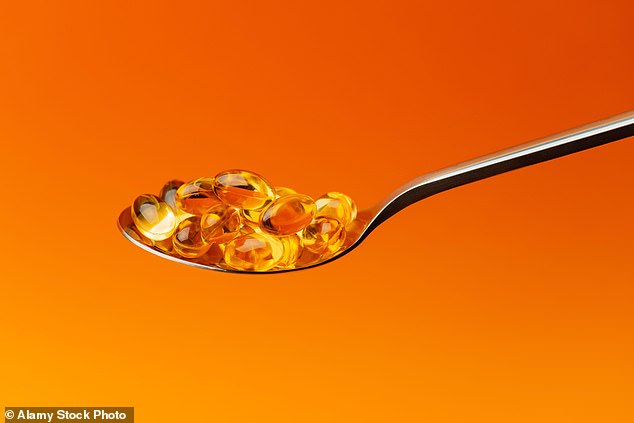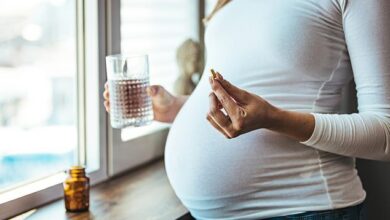Doctors reveal how much vitamin D you really need after this humid summer — and the surprising foods that can help



It has dampened our spirits, ruined many a get-together and cancelled countless sporting events. But could the cloudy, humid summer we have endured so far also be damaging our health, by depriving us of essential vitamin D in the sun?
After last week’s mini heatwave, the weather is mixed with mild sunshine and rain for the foreseeable future, making this an important question — because vitamin D is essential for not only maintaining bone health, but also keeping our immune systems working effectively, among other things. It’s even being studied as a way to reduce the risk of dementia.
But without access to sunlight (or the outdoors, it seems), most people can’t earn enough to meet their needs.
Our main source of vitamin D is exposure to ultraviolet B (UVB) radiation in sunlight. This causes the cholesterol in our skin to initiate a series of chemical reactions that create vitamin D.
But the amount of cloud we’ve had so far this summer (average sunshine hours are well below normal) will raise concerns that we’re not getting enough sunshine. The weather has also been so wet — parts of the UK have experienced their wettest May on record, according to the Met Office — that people are spending more time indoors than usual.

The weather has been so wet – parts of the UK have experienced their wettest May on record, according to the Met Office
Even when the weather is more benign, many of us are deficient in vitamin D. The latest UK National Diet and Nutrition Survey reported that between 2008 and 2012, almost a quarter of adults aged 19 to 64 and one in five adults over 65 had deficient levels in their blood.
In the dark and cloudy winter months from January to March, this figure rose to four in ten people between the ages of 19 and 64, and three in ten people over the age of 65.
Older people are at greater risk of deficiency because they are less able to absorb the vitamin from their diet (we get small amounts through oily fish and eggs, for example) and their bodies are less able to produce it.
There is some good news, though: while our sunlight exposure is likely to be “a little lower” this year, there are multiple factors that influence the amount of vitamin D you produce, so this needn’t be a problem, says Adrian Martineau, professor of respiratory infections and immunity at Queen Mary University of London.
“The ability of sunlight to synthesize vitamin D in the skin is related to the intensity of UVB rays, and that intensity is affected by cloud cover and latitude. So the further you are from the equator, the more atmosphere the sun’s rays have to pass through before they hit the Earth,” he explains.
Therefore, in the summer, when our part of the world is more oriented towards the sun, the intensity of the sun rays that reach our country increases, allowing us to replenish our vitamin D levels.
Still, other factors come into play, he says. “These include the time of day — UVB is strongest between 10 a.m. and 2 p.m. — how much time you spend outside, and whether you wear sunscreen.” (Though some experts say people rarely apply sunscreen thickly enough to block vitamin D production.)

Vitamin D is essential for maintaining the health of not only our bones, but also for the proper functioning of our immune system.
And behaviour really matters, because while you might assume that warmer countries would have lower rates of vitamin D deficiency, that’s not the case. “Saudi Arabia has much higher rates of vitamin D deficiency than we do in the UK, because it can be so hot there that they don’t go out in the sun,” says Professor Martineau.
Because vitamin D is so important to our well-being, the Department of Health recommended in 2016 that all adults and children should take a 10mcg supplement daily between October and March. In winter, there is often not enough sunlight to produce sufficient vitamin D.
According to Professor Martineau, exposure to sunlight in spring is perhaps the most important, because ‘it is in spring that our sun levels are typically at their lowest and we need the biggest boost’.
While brief exposure to sunlight can help restore your vitamin D levels (vitamin D is a fat-soluble vitamin and can be stored in the body and used at a later time), it has a limited shelf life.
The half-life of calcidiol [the form of vitamin D that circulates in the body] “The average period is one to two months. That means if you’re in a submarine or suddenly deprived of sunlight, your vitamin D stores are halved every one to two months,” adds Professor Martineau.
Still, summer weather doesn’t have to be glorious to top up your vitamin D levels. Susan Lanham-New, a professor of human nutrition at the University of Surrey who was part of the government working group that drew up the 2016 recommendations, says that even on a cloudy day, there can be enough UVB to help boost levels — as long as you can get outside.
“It doesn’t matter if it’s a sunny day, you can still get enough UVB exposure,” she told Good Health. “As long as it’s April to September, the UVB wavelength is strong enough. Even if it’s cloudy during these months, you should get enough UVB exposure to allow your body to make enough vitamin D.”
Crucially, however, she adds: ‘Our findings suggest that you should spend at least ten to twenty minutes in the sun every day, but you should not burn your skin in any way.’
People with dark brown skin who rarely burn may need to spend 25 minutes in the sun to get enough exposure because their skin is less likely to absorb UVB radiation, according to a 2018 study from the University of Manchester published in the journal Nutrients.
As for taking a vitamin D supplement, Professor Lanham-New says: ‘Unless you can’t go outside – because you’re frail or old, for example – or you can’t expose your skin for cultural reasons, then you don’t need to take a supplement between April and September.’ She adds: ‘There’s no harm in taking a moderate-dose supplement all year round, although you may be wasting your money.’
Research also shows that vitamin D pills are not a complete replacement for getting the vitamin in a healthy diet.
In 2022, a five-year Harvard Medical School study that followed 26,000 middle-aged men and women who took daily supplements reported in The New England Journal of Medicine that the pills did not prevent bone fractures or osteoporosis even in people with low vitamin levels.
The study found that the supplements do not provide the benefits that even small amounts of vitamin B12 can provide naturally from foods like oily fish, eggs and red meat.
Other sources include fortified breakfast cereals, breads, and some children’s yogurts.
NHS dietitian Catherine Collins adds: ‘Mushrooms can also be a good source, which is useful for vegans. It’s produced in the gills on the underside in response to sunlight, so you should turn them upside down and leave them on a windowsill for a few days.’
If anyone needed any more encouragement to get out into the sun, there are more health benefits than just vitamin D.
A 2014 study by Dr Richard Weller, an honorary dermatologist at the University of Edinburgh, found that sunlight increases the amount of nitric oxide in our bodies.
“This chemical dilates blood vessels and lowers our blood pressure,” he says. “My work shows that natural sunlight appears to prevent hypertension and cardiovascular disease, the world’s leading killer.”
All this makes it extra attractive to go outside this summer, even when it is cloudy and humid.
Additional reporting: Lucy Elkins
Recycling starts at home
How your body ‘recycles’ things. This week: Estrogen
In some women, menopause does not occur until after the average age of 51. One theory is that they are more efficient at recycling estrogen at that age.
When ‘old’ estrogen reaches the intestines after travelling through the body, it is either excreted in the feces or intestinal bacteria, the estrobolome, produce an enzyme that ‘reactivates’ it.
“There is some evidence for the influence of female hormones on the gut microbiome and the reabsorption of hormones in the gut,” said Dr Shazia Malik, a gynaecologist and obstetrician at the Royal Free London NHS Foundation Trust and Portland Hospital.




